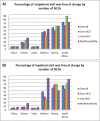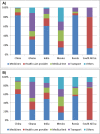Impact of Noncommunicable Disease Multimorbidity on Healthcare Utilisation and Out-Of-Pocket Expenditures in Middle-Income Countries: Cross Sectional Analysis
- PMID: 26154083
- PMCID: PMC4496037
- DOI: 10.1371/journal.pone.0127199
Impact of Noncommunicable Disease Multimorbidity on Healthcare Utilisation and Out-Of-Pocket Expenditures in Middle-Income Countries: Cross Sectional Analysis
Abstract
Background: The burden of non-communicable disease (NCDs) has grown rapidly in low- and middle-income countries (LMICs), where populations are ageing, with rising prevalence of multimorbidity (more than two co-existing chronic conditions) that will significantly increase pressure on already stretched health systems. We assess the impact of NCD multimorbidity on healthcare utilisation and out-of-pocket expenditures in six middle-income countries: China, Ghana, India, Mexico, Russia and South Africa.
Methods: Secondary analyses of cross-sectional data from adult participants (>18 years) in the WHO Study on Global Ageing and Adult Health (SAGE) 2007-2010. We used multiple logistic regression to determine socio-demographic correlates of multimorbidity. Association between the number of NCDs and healthcare utilisation as well as out-of-pocket spending was assessed using logistic, negative binominal and log-linear models.
Results: The prevalence of multimorbidity in the adult population varied from 3.9% in Ghana to 33.6% in Russia. Number of visits to doctors in primary and secondary care rose substantially for persons with increasing numbers of co-existing NCDs. Multimorbidity was associated with more outpatient visits in China (coefficient for number of NCD = 0.56, 95% CI = 0.46, 0.66), a higher likelihood of being hospitalised in India (AOR = 1.59, 95% CI = 1.45, 1.75), higher out-of-pocket expenditures for outpatient visits in India and China, and higher expenditures for hospital visits in Russia. Medicines constituted the largest proportion of out-of-pocket expenditures in persons with multimorbidity (88.3% for outpatient, 55.9% for inpatient visit in China) in most countries.
Conclusion: Multimorbidity is associated with higher levels of healthcare utilisation and greater financial burden for individuals in middle-income countries. Our study supports the WHO call for universal health insurance and health service coverage in LMICs, particularly for vulnerable groups such as the elderly with multimorbidity.
Conflict of interest statement
Figures





References
-
- Murray CJL, Vos T, Lozano R, Naghavi M, Flaxman AD, Michaud C, et al. Disability-adjusted life years (DALYs) for 291 diseases and injuries in 21 regions, 1990–2010: a systematic analysis for the Global Burden of Disease Study 2010. The Lancet. 2012;380(9859):2197–223. 10.1016/S0140-6736(12)61689-4 - DOI - PubMed
-
- Lozano R, Naghavi M, Foreman K, Lim S, Shibuya K, Aboyans V, et al. Global and regional mortality from 235 causes of death for 20 age groups in 1990 and 2010: a systematic analysis for the Global Burden of Disease Study 2010. The Lancet. 2012;380(9859):2095–128. 10.1016/S0140-6736(12)61728-0 - DOI - PMC - PubMed
-
- WHO Global status report on noncommunicable diseases 2010. World Health Organization.
Publication types
MeSH terms
Grants and funding
LinkOut - more resources
Full Text Sources
Other Literature Sources
Miscellaneous

